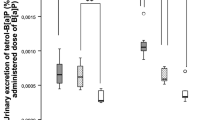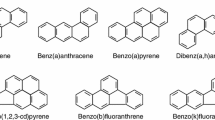Abstract
The aryl hydrocarbon hydroxylase (AHH) inducing potency of toxic chlorinated aromatic hydrocarbons such as polychlorinated dibenzofurans (PCDFs), polychlorinated biphenyls (PCBs) and 2,3,7,8-tetrachlorodibenzo-p-dioxin (TCDD) was studied in the young male Wistar rats. Alternatively, a technical PCDF mixture, 15 individual PCDF isomers or TCDD were administered i.p. in doses of 5 μg/kg; a PCB mixture was given in a dose of 50 mg/kg. The order of AHH inducing ability was TCDD > PCDFs ≫ PCBs in kidney, lung, and liver. In the prostate, thymus, and spleen, only TCDD enhanced the AHH activity. The AHH inducibility in the lung and liver, induced by 15 pure PCDF isomers with varying chlorine substitutions was also examined. Only 2,3,7,8-tetrachlorodibenzofuran (2,3,7,8-tetra-CDF) and 2,3,4,7,8-pentachlorodibenzofurans (2,3,4,7,8-penta-CDF) significantly induced the hepatic AHH activity (4- and 2-fold, respectively), while eight PCDF isomers, including these two, significantly enhanced the pulmonary AHH activity (6- to 30-fold). Taking into account both the potent AHH inducibility and the high bioaccumulation of these compounds, 2,3,7,8-tetra- and 2,3,4,7,8-penta-CDF should be given due attention with regard to environmental-related factors and the possibility of involvement in the etiology of “Yusho” disease.
Similar content being viewed by others
References
Ahling B, Lindskog A, Jansson B, Sundström (1977) Formation of polychlorinated dibenzo-p-dioxins and dibenzofurans during combustion of a 2,4,5-T formulation. Chemosphere 6: 461–468
Bowes GW, Mulvihill MJ, Simoneit BRT, Burlingame AL, Risebrough RW (1975) Identification of chlorinated dibenzofurans in American polychlorinated biphenyls. Nature 256: 305–307
Buser HR (1969) Formation of polychlorinated dibenzofurans (PCDFs) and dibenzo-p-dioxins (PCDDs) from the pyrolysis of chlorobenzenes. Chemosphere 8: 415–424
Buser HR, Bosshardt H-P, Rappe C (1978a) Formation of polychlorinated dibenzofurans (PCDFs) from the pyrolysis of PCBs. Chemosphere 7: 109–119
Buser HR, Bosshardt H-P, Rappe C, Lindahl R (1978b) Identification of polychlorinated dibenzofuran isomers in fly ash and PCB pyrolysis. Chemosphere 7: 419–429
Buser HR, Bosshardt H-P, Rappe C (1978c) Identification of polychlorinated dibenzo-p-dioxin isomers found in fly ash. Chemosphere 7: 165–172
Jensen S, Renberg L (1972) Contaminants in pentachlorophenol: chlorinated dioxins and predioxins (chlorinated hydroxydiphenylethers). Ambio 1: 62–65
Kuroki H, Masuda Y (1978) Determination of polychlorinated dibenzofuran isomers retained in patients with Yusho. Chemosphere 7: 771–777
Kuroki H, Masuda Y, Yoshihara S, Yoshimura H (1980) Accumulation of polychlorinated dibenzofurans in the livers of monkeys and rats. Fd Cosmet Toxicol 18: 387–392
Lee IP, Suzuki K, Nagayama J (1981) Metabolism of benzo(a)pyrene in rat prostate glands following 2,3,7,8-tetrachlorodibenzo-p-dioxin exposure. Carcinogenesis 2: 823–831
Lowry OH, Rosebrough NJ, Farr AL, Randall RJ (1951) Protein measurements with the Folin phenol reagent. J Biol Chem 193: 265–275
Masuda Y, Kuratsune M (1979) Toxic compounds in the rice oil which caused Yusho. Fukuoka Acta Med 70: 229–237
McConnell EE, Mckinney JD (1978) Exquisite toxicity in the guinea pig to structurally similar halogenated dioxins, furans, biphenyls and naphthalenes. Toxicol Appl Pharmacol (Abstr) 45: 298
Nagayama J, Kuratsune M, Masuda Y (1976) Determination of chlorinated dibenzofurans in Kanechlors and “Yusho oil”. Bull Environ Contam Toxicol 15: 9–13
Nagayama J, Masuda Y, Kuratsune M (1977) Determination of polychlorinated dibenzofurans in tissues of patients with ‘Yusho’. Fd Cosmet Toxicol 15: 195–198
Olie K, Vermeulen PL, Hutzinger O (1977) Chlorodibenzo-p-dioxins and chlorodibenzofurans are trace components of fly ash and flue gas of some municipal incinerators in the Netherlands. Chemosphere 6: 455–459
Poland A, Glover E (1973) Chlorinated dibenzo-p-dioxins: Potent inducers of δ-aminolevulinic acid synthetase and Aryl hydrocarbon hydroxylase. II. A study of the structure-activity relationship. Mol Pharmacol 9: 736–747
Poland A, Glover E (1975) Genetic expression of Aryl hydrocarbon hydroxylase by 2,3,7,8-tetrachlorodibenzo-p-dioxin: Evidence for a receptor mutation in genetically nonresponsive mice. Mol Pharmacol 11: 389–398
Poland A, Glover E (1980) 2,3,7,8-Tetrachlorodibenzo-p-dioxin: segregation of toxicity with the Ah locus. Mol Pharmacol 17: 86–94
Rappe C, Buser HR, Kuroki H, Masuda Y (1979) Identification of polychlorinated dibenzofurans (PCDFs) retained in patients with Yusho. Chemosphere 8: 259–266
Rappe C, Buser HR, Stalling DL, Smith LM, Dougherty RC (1981) Identification of polychlorinated dibenzofurans in environmental samples. Nature 292: 524–526
Vos JG, Koeman JH, van der Maas HL, ten Noever de Brauw MC, de Vos RH (1970) Identification and toxicological evaluation of chlorinated dibenzofuran and chlorinated naphthalene in two commercial polychlorinated biphenyls. Fd Cosmet Toxicol 8: 625–633
Yoshihara S, Nagata K, Yoshimura H, Kuroki H, Masuda Y (1981) Inductive effect on hepatic enzymes and acute toxicity of individual polychlorinated dibenzofuran congeners in rats. Toxicol Appl Pharmacol 59: 580–588
Yoshimura H, Yoshihara S, Ozawa N, Miki M (1979) Possible correlation between induction modes of hepatic enzymes by PCBs and their toxicity in rats. Ann NY Acad Sci 320: 179–192
Author information
Authors and Affiliations
Additional information
A part of this work was presented at the 51st annual meeting of the Japanese Society for Hygiene, May 1–3, 1981, Sapporo, Japan and the 52nd annual meeting of the Japanese Society for Hygiene, March 29–31, 1982, Tokyo, Japan
Rights and permissions
About this article
Cite this article
Nagayama, J., Kuroki, H., Masuda, Y. et al. A comparative study of polychlorinated dibenzofurans, polychlorinated biphenyls and 2,3,7,8-tetrachlorodibenzo-p-dioxin on aryl hydrocarbon hydroxylase inducing potency in rats. Arch Toxicol 53, 177–184 (1983). https://doi.org/10.1007/BF00316501
Received:
Issue Date:
DOI: https://doi.org/10.1007/BF00316501




